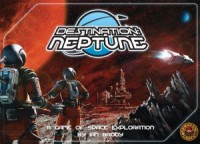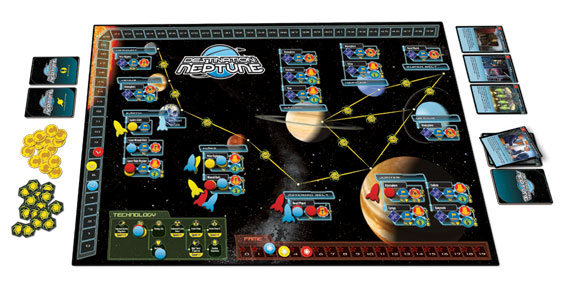
Destination: Neptune
2-4
12+
90+
DESTINATION: NEPTUNE shows an optimistic vision of commercial space exploration in the next century. Control an organization with the resources and intent to explore, develop, and colonize the worlds beyond Earth. Organizations that practice careful planning and resource management, with a healthy dose of technology research will succeed.
Destination: Neptune moves through four generations of space exploration. Players earn Victory Points by building large commercial outposts and colonies, as well as from fame and outright purchases. After four generations, the player with the most Victory Points wins the game.

images © Griggling Games
User Reviews (1)
Add a Review for "Destination: Neptune"
You must be logged in to add a review.


I’m a fan of High Frontier from Sierra Madre games, but some folks feel intimidated by its apparent complexity. Destination Neptune shares a lot of the same things which I love about HF – it was designed by an actual space scientist, has technology based on what is currently available to various space agencies now and what they could have within the next 100 years, and is all about mankind taking his first real steps into space to explore, exploit, and colonize our solar system.
The object of the game is to be the player with the most Victory Points at the game’s end. There are four decks of cards which players will be drawing from which represent each generation of space exploration (a generation is 25 years). Each deck is used in turn until it is empty and then a scoring round takes place. Once relative scores have been determined, play resumes with the next generation deck. The game ends immediately when the last card of the fourth generation is drawn. This triggers the final scoring round and a winner is determined.
The game board is well illustrated and represents the Solar System, the various planets, (some of) their moons, and other locations – such as Ceres or Pluto (sadly, no longer a “planet”) – which players can travel to. Each location has a series of spaces next to it: one with a satellite which denotes a scientific mission, one with a flag which denotes a base, and one (or possibly two) which denote areas to be exploited (more common that colony sites) or colonized.
Lines between the various locations represent the orbital flight paths which a Construction Team (see below) must follow in order to reach specific destinations and are also marked with how much fuel must be spent to move from point to point. The total fuel needed is calculated by adding up the total amount of fuel on the flight path and can be modified by various technologies and the presence of bases along the route.
Each location on the map represents an area which can be exploited in some way or another. These locations have three spaces associated with it (as mentioned above) each of which is necessary in order to build the next in line. Base, Colony, and Factory spaces at locations may also have one (or more) icons next to them indicating which advanced technologies a player must have first in order to build into that space. Example: In order to build a base on Triton a player must first be part of a Scientific Mission to Triton AND have High Efficiency Insulation technology.
Each player starts the game with the following:
3 Construction Teams (they look like rockets), 5 credit counters (money), 5 fuel counters (needed to fly your rockets). Also, off to the side, are a pile of 35 (for each player) small wooden disks used to mark off ownership of various missions, locations, and technologies as pay progresses. Each player is dealt 5 cards from the first generation deck.
On his turn a player does the following things:
1) He MAY sell a card to the Opportunity Track. The Opportunity Track is a row of cards placed along the bottom of the game board. By doing so, the player receives either one or two credits (depending on the number of players). Selling a card to the Opportunity Track does not prevent it from being played later (see playing a card, below). The maximum number of cards which can be in the Opportunity Track is based (again) on the number of players. When it is full, and a player sells a card to the track, the first card drops off and is moved to the discard pile.
2) He MUST play a card, either from his hand or from the Opportunity Track. The main difference here is that a player only gains the Fame points associated with a card when playing it from his hand. Fame points are used for two things: 1) they may provide additional Victory Points when during a scoring round, or 2) they may be exchanged for credits on a 2 for 1 basis when an Attract Investors card is played. Once a card is played – from either place – it is moved to the discard pile.
3) He refills his hand back up to five cards. He first draws from the current generation deck. If he depletes the current generation deck and still does not have 5 cards, he continues to draw up to five from the next deck. As above, when the last card of a generation deck is drawn, a scoring round occurs.
All of the actions in the game – establishing scientific missions, building, acquiring new technologies, attracting investors, etc… – occur as a result of playing a card. On your turn, when you play a card, you take an action as stated on the card. BUT, you are not the only one to take advantage of your actions. Having played a card, and taken your action, each of the other players may also take an action. Example: You play a build card to build a base on the moon. Now each player, moving clockwise, also gets a chance to build something somewhere.
This sort of shared actions means that you need to take your opponents possible gains into account as well as your own. Do you develop a new technology now? By so doing your opponents could gain access to it now, and then, on their turn, they may be able to build a base somewhere which required them to have that technology before you can. Building in, or deploying scientific missions to, various locations first is important as it effects scoring (both of Fame and Victory points). Any number of players can share a scientific mission and base at any given location. But only one player can have a factory and/or colony at a location.
This, along with the timing of actions, makes for a lot of jockeying for positions around the map. Is Fame more important to you, or do you want to try and build more factories and colonies without regard for who took the “one small step for man…”?
All in all, I found Destination Neptune to be both fun and engaging. I intend to buy a copy as soon as I can (which is always the highest recommendation I can give any game).
UPDATE I got a copy of the game this past Xmas (2015), so now I can play to my heart’s content.